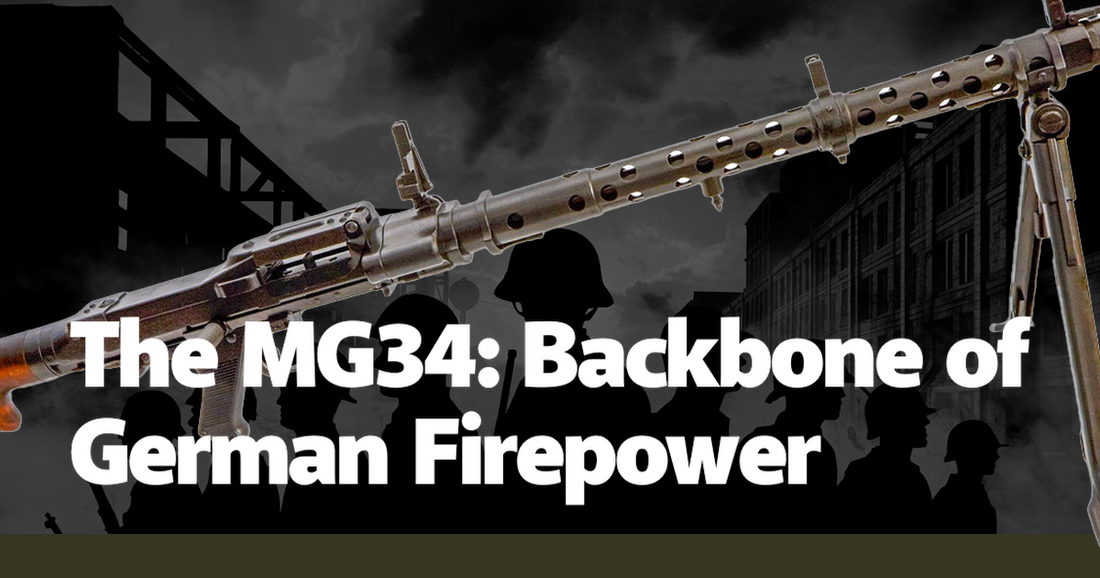The MG34, a machine gun that emerged from the interwar period, became the backbone of German firepower during World War II. Its influence on the battlefield was profound, reshaping infantry tactics and providing a level of firepower that was unparalleled at the time. Designed by Heinrich Vollmer in the late 1920s and early 1930s, the MG34 was the first general-purpose machine gun (GPMG), capable of being deployed in various roles, including as a light machine gun (LMG) and a heavy machine gun (HMG). This versatility made it a cornerstone of the Wehrmacht’s firepower strategy, allowing German forces to adapt quickly to changing combat scenarios.
One of the most significant features of the MG34 was its rate of fire. Capable of firing between 800 to 900 rounds per minute, it outpaced many contemporary machine guns, providing an overwhelming volume of fire that could suppress enemy troops and disrupt their maneuvers. This high rate of fire was achieved through a recoil-operated mechanism, which was both reliable and efficient. The MG34’s design also included a quick-change barrel system, allowing gunners to replace overheated barrels rapidly and maintain sustained fire during prolonged engagements. This feature was crucial in both offensive and defensive operations, ensuring that the MG34 could continue to deliver firepower without interruption.
The MG34’s impact on German infantry tactics cannot be overstated. Its introduction allowed for more flexible and dynamic maneuvering on the battlefield. German infantry squads were reorganized around the machine gun, with the MG34 serving as the squad’s primary weapon. This shift in tactics emphasized the importance of fire and movement, where the MG34 would lay down suppressive fire while riflemen advanced or repositioned. This approach proved devastatingly effective during the early years of World War II, contributing to the rapid successes of the Blitzkrieg campaigns in Poland, France, and the Soviet Union.
In addition to its role within infantry squads, the MG34 was also mounted on vehicles, including tanks and half-tracks, further extending its utility. For example, the Panzer III and Panzer IV tanks were equipped with MG34s as coaxial and hull-mounted machine guns, providing essential fire support against infantry and light vehicles. The versatility of the MG34 meant that it could be adapted for anti-aircraft roles as well, mounted on tripods or specialized AA mounts to defend against low-flying aircraft. This adaptability made the MG34 an indispensable tool across multiple theaters of war, from the deserts of North Africa to the forests of Eastern Europe.
Despite its many advantages, the MG34 was not without its drawbacks. Its precision-engineered components required meticulous maintenance and were susceptible to dirt and debris, which could cause malfunctions in harsh combat conditions. Additionally, the high rate of fire, while advantageous in many situations, also led to rapid ammunition depletion, necessitating a robust supply chain to keep gunners adequately supplied. These challenges were partially addressed with the introduction of the MG42, which was designed to be more rugged and easier to mass-produce. However, the MG34 remained in widespread use throughout the war due to its proven effectiveness and the sheer number already in service.
Anecdotes from the front lines illustrate the MG34’s formidable reputation. Veterans from both the Axis and Allied forces often recounted the distinctive sound of the MG34’s rapid fire, describing it as a “buzz saw” that could cut down anything in its path. Allied soldiers learned to respect and fear the MG34, often prioritizing its neutralization during engagements. German machine gunners, on the other hand, took pride in their weapon, knowing that they wielded one of the most advanced and effective machine guns of the era. Stories of MG34 crews holding off superior enemy numbers with disciplined bursts of fire became legendary, cementing the gun’s status as a symbol of German military prowess.
The legacy of the MG34 extends beyond its operational use during World War II. It set a new standard for machine gun design, influencing post-war developments in small arms. The concept of a general-purpose machine gun, capable of fulfilling multiple roles on the battlefield, was adopted by many other nations in the subsequent decades. The MG34’s successor, the MG42, further refined these principles and continued to serve as a model for modern machine guns. Today, the MG34 is remembered not only as a technological marvel of its time but also as a key element in the evolution of infantry firepower.
In conclusion, the MG34 was more than just a weapon; it was a game-changer that redefined the role of machine guns in modern warfare. Its high rate of fire, versatility, and impact on tactics made it an essential component of German military strategy. While it had its limitations, the MG34’s contributions to the German war effort and its lasting influence on small arms design are undeniable. As we look back on the history of military technology, the MG34 stands out as a testament to the ingenuity and adaptability that shaped the course of World War II and beyond.

